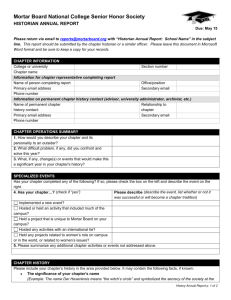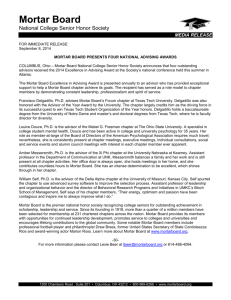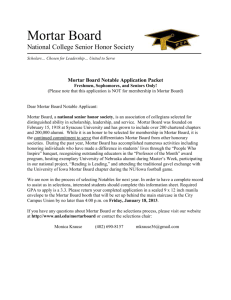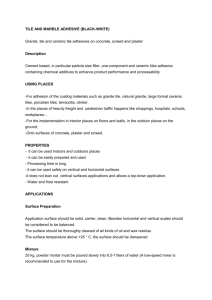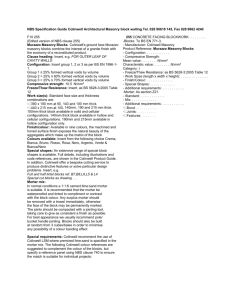Inform Guide - Repointing Ashlar Masonry
advertisement
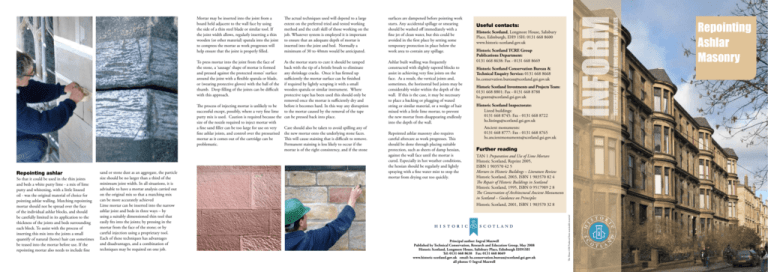
The actual techniques used will depend to a large extent on the preferred tried and tested working method and the craft skill of those working on the job. Whatever system is employed it is important to ensure that an adequate depth of mortar is inserted into the joint and bed. Normally a minimum of 30 to 40mm would be anticipated. surfaces are dampened before pointing work starts. Any accidental spillage or smearing should be washed off immediately with a fine jet of clean water, but this could be avoided in the first place by setting some temporary protection in place below the work area to contain any spillage. As the mortar starts to cure it should be tamped back with the tip of a bristle brush to eliminate any shrinkage cracks. Once it has firmed up sufficiently the mortar surface can be finished if required by lightly scraping it with a small wooden spatula or similar instrument. Where protective tape has been used this should only be removed once the mortar is sufficiently dry and before it becomes hard. In this way any disruption The process of injecting mortar is unlikely to be successful except, possibly, where a very fine lime to the mortar caused by the removal of the tape putty mix is used. Caution is required because the can be pressed back into place. size of the nozzle required to inject mortar with Care should also be taken to avoid spilling any of a fine sand filler can be too large for use on very fine ashlar joints, and control over the pressurised the new mortar onto the underlying stone faces. This will cause staining that is difficult to remove. mortar as it comes out of the cartridge can be Permanent staining is less likely to occur if the problematic. mortar is of the right consistency, and if the stone Ashlar built walling was frequently constructed with slightly tapered blocks to assist in achieving very fine joints on the face. As a result, the vertical joints and, sometimes, the horizontal bed joints may be considerably wider within the depth of the wall. If this is the case, it may be necessary to place a backing or plugging of waxed string or similar material, or a wedge of hair mixed with a little lime mortar, to prevent the new mortar from disappearing endlessly into the depth of the wall. To press mortar into the joint from the face of the stone, a ‘sausage’ shape of mortar is formed and pressed against the protected stones’ surface around the joint with a flexible spatula or blade, or (wearing protective gloves) with the ball of the thumb. Deep filling of the joints can be difficult with this approach. Repointing ashlar So that it could be used in the thin joints and beds a white putty lime - a mix of lime putty and whitening, with a little linseed oil - was the original material of choice for pointing ashlar walling. Matching repointing mortar should not be spread over the face of the individual ashlar blocks, and should be carefully limited in its application to the thickness of the joints and beds surrounding each block. To assist with the process of inserting this mix into the joints a small quantify of natural (horse) hair can sometimes be teased into the mortar before use. If the repointing mortar also needs to include fine sand or stone dust as an aggregate, the particle size should be no larger than a third of the minimum joint width. In all situations, it is advisable to have a mortar analysis carried out on the original mix so that a matching mix can be more accurately achieved Lime mortar can be inserted into the narrow ashlar joint and beds in three ways – by using a suitably dimensioned thin tool that easily fits into the joints; by pressing in the mortar from the face of the stone; or by careful injection using a proprietary tool. Each of these techniques has advantages and disadvantages, and a combination of techniques may be required on one job. Repointed ashlar masonry also requires careful aftercare as work progresses. This should be done through placing suitable protection, such as sheets of damp hessian, against the wall face until the mortar is cured. Especially in hot weather conditions, the hessian should be regularly and lightly spraying with a fine water mist to stop the mortar from drying out too quickly. Repointing Ashlar Masonry Useful contacts: Historic Scotland, Longmore House, Salisbury Place, Edinburgh, EH9 1SH: 0131 668 8600 www.historic-scotland.gov.uk Historic Scotland TCRE Group Publications Department: 0131 668 8638: Fax - 0131 668 8669 Historic Scotland Conservation Bureau & Technical Enquiry Service: 0131 668 8668 hs.conservation.bureau@scotland.gsi.gov.uk Historic Scotland Investments and Projects Team: 0131 668 8801: Fax - 0131 668 8788 hs.grants@scotland.gsi.gov.uk Historic Scotland Inspectorate: Listed buildings: 0131 668 8745: Fax - 0131 668 8722 hs.listings@scotland.gsi.gov.uk Ancient monuments: 0131 668 8777: Fax - 0131 668 8765 hs.ancientmonuments@scotland.gsi.gov.uk Further reading TAN 1 Preparation and Use of Lime Mortars Historic Scotland, Reprint 2005, ISBN 1 903570 42 5 Mortars in Historic Buildings – Literature Review Historic Scotland, 2003, ISBN 1 903570 82 4 The Repair of Historic Buildings in Scotland Historic Scotland, 1995, ISBN 0 9517989 2 8 The Conservation of Architectural Ancient Monuments in Scotland – Guidance on Principles Historic Scotland, 2001, ISBN 1 903570 32 8 Principal author: Ingval Maxwell Published by Technical Conservation, Research and Education Group, May 2008 Historic Scotland, Longmore House, Salisbury Place, Edinburgh EH91SH Tel: 0131 668 8638 Fax: 0131 668 8669 www.historic-scotland.gov.uk email: hs.conservation.bureau@scotland.gsi.gov.uk all photos © Ingval Maxwell The House 4/08 Produced from sustainable material Mortar may be inserted into the joint from a board held adjacent to the wall face by using the side of a thin steel blade or similar tool. If the joint width allows, regularly inserting a thin wooden (or other material) spatula into the joint to compress the mortar as work progresses will help ensure that the joint is properly filled. Practical considerations The nature of ashlar Introduction The Romans brought the technique of squaring and building regular sized stone blocks - ashlar - to Scotland. The technique then fell into disuse but, with the coming of the great monastic orders from the 11th century onwards, building in ashlar was revived as revealed by the construction of their great Abbeys and associated building ranges. On the defensive front, the use of ashlar was relegated to the creation of dressed stone surrounds to doors, windows, corners and other structural features during the building of Scotland’s medieval castles. In more peaceful times, by the 17th and early 18th centuries it was being used more extensively to create fine dressed stone facades of the great country mansions such as Kinross, Duff and Hopetoun, and rich merchants’ houses in towns and cities. Although well-established by this pedigree it was only from the mid-nineteenth century, when stone quarrying and working techniques became more mechanised and economic, that it became possible to build domestic dwellings that incorporated ashlar facades. Found equally on city tenements, villas, and rural farmhouses this approach to building lasted into the early decades of the 20th century. With Scotland’s geological diversity, a wide range of stones have been used in the creation of ashlar buildings although, in most parts of the country, the use of sandstone predominates. Rough quarry blocks were carefully cut into precise cuboid shapes with a tooled or smooth polished external faces. Edges were cut square and true so that each block could nestle closely with its neighbour when set into the wall. Courses of stones were cut to exactly the same height, in random lengths, and laid with a “broken bond” so that the middle of the blocks on the next course sat directly above the vertical joint on the underlying course to give the wall maximum load-bearing strength. The surface finish of buildings with ashlar walling differed from that of building with rubble walling in that the use of the lime mortar was limited to filling the fine joints and beds which surrounded each block. Joint and bed dimension generally only amounted to a few millimetres in thickness at the surface, with this reducing to a “paper thickness” as a result of the accuracy in block cutting during Georgian times. During this period, the exposed face of the ashlar block may also have been adorned with a chamfer, which created the illusion of V-shaped joints when the blocks were put together, or were tooled in such a way as to emulate a rock cut finish. In each case, the mortar joints and beds were of small dimension. Water vapour egress through the lime mortar joints of ashlar masonry needs to be recognised as an important part of how traditional buildings breathe and cope with rain water. If this process is prevented from happening a number of damp related problems and consequences can emerge. The most common cause of such problems is the use of cement-based mortars to repoint the walling and this should be avoided in all repair work. Commonly cement mortar is either smeared over the stone face or formed into projecting straps of mortar that cover the joints and beds in addition to parts of the stone. Both approaches encourage rainwater to penetrate and be retained within the wall structure and this can lead to significant stone decay. Although the basic principle of only using lime-based mortars applies to the repointing of ashlar stone work, the fine joints in the build require additional care whilst undertaking such work. The care and attention which was exercised during the building process needs to be recognised whenever repointing repair work is carried out and, consequently, the amount of time and skill required to do the work properly should not be underestimated. A total repointing may not always be necessary if only part of the original mortar has decayed. A partial repoint using a mortar mix similar to the original is often all that is required. This cautionary approach also helps to eliminate some of the risk of damage to the stones that can occur during the various stages involved in repointing. Other situations can emerge where a complete repoint is essential e.g. where the effects of weather on softer sandstones have had their faces more generally eroded. On no account should a cement based mortar be used to repoint ashlar but, if at some time in the building’s past, superficial cementitious over-pointing has been inappropriately applied, this can sometimes be removed by carefully picking it off without damage to the stone’s edges. Where the cement based material is still sound or resistant to removal it will be necessary to evaluate the likely damage that could be caused by leaving it in place against the damage which would be caused by its removal. Sometimes the best practical option is to leave the cement mortar in place, accept the existing appearance and, possibly, any ongoing related masonry decay. Preparing ashlar for repointing Before starting any repointing work, a detailed evaluation should be carried out to determine the full extent of the required work. It is also essential that the work is carried out in appropriate weather conditions, and that it is protected from the effects of both sun and rain until it is cured. Care will be essential when raking out the joints and beds, and it is generally inadvisable to use chisels or power tools to cut out the decayed or loose mortar from the fine joints due to the risk of damage to the stone. Decayed mortar should be removed by carefully picking it out with a thin steel hook, or by easing the redundant material out by means of a hand-held hacksaw blade inserted into the joint and gently pulled forward. After flushing out the open joints and beds with a jet of clean water, and damping it down, the process of inserting fresh putty lime mortar into the fine joints should start by taping over the stones’ arrises with heavy duty sticky-backed tape, or similar material, to protect the adjacent stones against staining and mechanical damage. Care needs to be exercised in the choice of the protective tape as some brands can leave an adhesive residue on the stone’s surface and this can be difficult to remove. Before work starts, the chosen tape should be tested in a discrete location to determine if this will happen.

